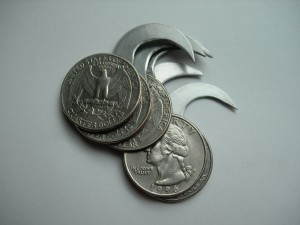
Economies of Concept at MOCA
First thing to watch out for when walking around the new exhibit at MOCA, “Claire Fontaine: Economies,” is the floor. There’s a snaking pressure cable that can trip you up, as can a ton of tennis balls in another room. If you do step on that cable, an alarm goes off, echoing around the chambers, although you might not know it was your own foot that set it off. But this is a rather simple description of a highly conceptual show, the first comprehensive American outing for the French-based Claire Fontaine.
How conceptual? Take for example that Claire Fontaine is actually a collective and takes its name from a French paper company — “she,” then, is a ready-made artist. She makes work that asks the viewer to question the making of art, the consumption of art, and more basically the economies of our daily lives. It’s a pretty broad trek, but there are over 30 pieces here to guide you through the exploration.
Back to the tennis balls. They are split open so you can see the contents inside, which include simple items such as gum, batteries, condoms. They reference a way that contraband is smuggled into prisons, by throwing tennis balls over the prison walls with goodies stuffed inside. It’s one way an underground economy functions.
Another way is by paying for products with the increasingly old-fashioned vehicle, the paper check. Claire Fontaine (in fact a British and Italian duo) asked “her” galleries across the world to take a leap of faith and sign a blank check — the series of them are hung on a wall in the exhibit, almost transformed into drawings themselves in such a context. But there is still the possibility that they could revert to their old form, and be used by somebody to write any amount to themselves. There are other pieces with a similar vein, including a unique set of keys.
As for questions of art production, the neon sculpture “This neon sculpture was made by…” goes straight to the point, by naming the fabricator (in the artworld, many pieces — while the artist’s idea — are actually made by a hired fabricator) and the price. It’s a nice commentary.
As for over-arching “Economies,” maybe one of the most intriguing pieces is a black-and-white video, text only. It is the suicide note from Joseph Stack, the software engineer who flew his plane into an IRS building last February. He writes about how hard he tried to make it legitimately, only to get screwed over time and again by financial and governmental fortresses. It’s a powerful cry for help, and ends in terrible violence.
On a lighter note, another video simply follows Claire Fontaine’s night-time taxi ride into South Beach, interviewing the female cab driver who, it turns out, has has a pretty interesting history herself.
The entire ride of the show can take some concentration to navigate, but it’s another MOCA show that adds another layer to Miami’s artistic experience.
Talk
And it’s the type of show that calls out for a lecture with the “assistants” of Claire Fontaine, Fulvia Carnevale and James Thornbill, which the museum will provide tomorrow, Saturday, at 2 p.m.
“Claire Fontaine: Economies,” through Aug. 22, at MOCA, 770 NE 125th St, North Miami; 305-893-6211. Artist Lecture, Sat. June 5, 2 p.m.; rsvp requested: 305-893-6211, or [email protected].
Recent Content
-
Artsarticle ·
-
Artsarticle ·
-
Artsarticle ·

